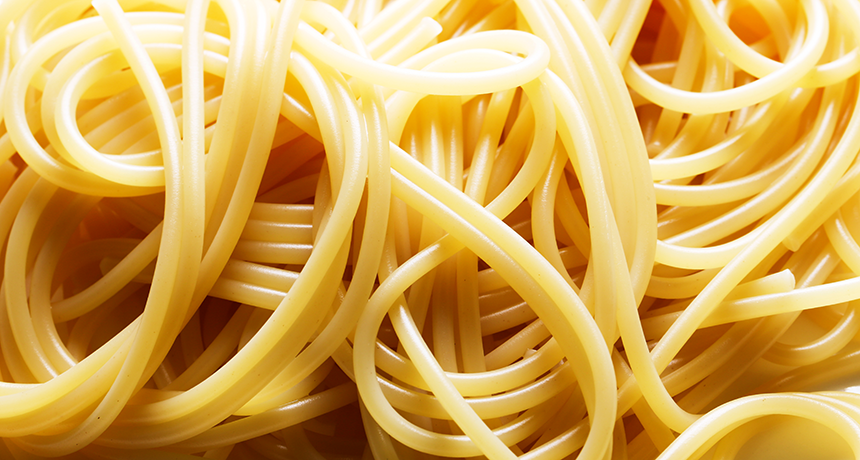Plant-powered plastics
Scientists are using green materials to create more Earth-friendly plastics

Plastic contains polymers, molecules that are linked into long chains. Under a microscope, polymers resemble these tangled strands of spaghetti.
CHRISTIANCHAN/ISTOCKPHOTO
If you looked at the plastic in your sneakers under a high-powered microscope, it would resemble cooked spaghetti, with each noodle tangled in the others.
Plastics are made of groups of many atoms — the smallest building block of any element — linked together into molecules. Molecules, in turn, are the smallest complete unit of any chemical. In plastics, the molecules are linked into long chains called polymers.
Polymers “become entangled with each other much like a single strand of cooked spaghetti gets tangled up with other spaghetti strands in a bowl of pasta,” explains Annette Jacobson. She’s a chemical engineer at Carnegie Mellon University in Pittsburgh.
That entanglement makes it hard to break plastic.j And that’s a good thing when it’s in your sneakers, toothbrush, bike helmet or hundreds of other products we use every day. But plastic’s strength is also its weakness — at least when it comes to the environment.
The reason: Plastic takes years, sometimes centuries, to completely break down. So our garbage dumps fill up with discarded plastic — bags, food containers, tattered soccer balls and, yes, even old sneakers.
Some plastic products even end up in the ocean. There currents gather the trash into what’s known as the Great Pacific Garbage Patch. Marine animals get tangled up in plastic. Sometimes they mistake plastic bags for food, because they look a lot like jellyfish. Scientists have found plastic in the stomachs of dead seabirds, fish and turtles.
“Recycling programs address some of those concerns. But not everyone recycles,” notes Art Ragauskas. He is a Georgia Institute of Technology chemist in Atlanta who is working to make plastics safer.
Problems with plastics
Some of the chemicals used to make plastic, such as plasticizers, do break down.
Plasticizers are chemicals used to make materials flexible. But over time the plasticizers’ molecules break off or slide out of the plastic. Now they can end up in the air and on surfaces around our homes and the environment. People can breathe in these pollutants. If they come from a plastic used to package or serve foods, plasticizers could even end up tainting what we eat and drink. Scientists worry about the effects that these pollutants may have on our health.
Phthalates (THAAL’ aytz) are one family of plasticizers. Though widely used, phthalates have been linked to serious health problems, including certain types of cancer and birth defects.
American, Canadian and European governments have banned several types of phthalates in children’s toys. But phthalates still are used in products such as shower curtains, car parts and food packaging. That means most of us are exposed to phthalates every day.
Another major problem with plastics is that most are made using oil and gas. Remember those polymer spaghetti noodles? Well, they don’t occur naturally. Chemists manufacture polymers out of hydrocarbons, which are ingredients of oil and gas.
Currently, about 4 percent of the crude oil (oil in its natural state, before processing) used by industrialized countries is converted into plastic. Another 4 percent is used to run equipment in the factories that make plastic.
Getting that oil out of the ground often involves cutting down trees and digging up the ground, destroying the habitat of many wild animals. And oil and gas are nonrenewable resources, which means once they’re gone, they’re gone.
“We all know the oil fields eventually will be empty,” says Ragauskas. “Do we really want to hinge our economic success for our children’s children on a resource that’s becoming more and more difficult to find? I think the answer is no.”
How much plastic?
Because people use so much plastic, its effect on the environment is a big deal. There were 1.5 million metric tons (3.3 billion pounds) of transparent plastic sold in North America in 2010. By 2015, that number could reach 1.8 million metric tons. In the United States, sales of plastics total more than $374 billion each year.

“Go to any grocery store and look at what is plastic and you’ll go ‘Holy smokes!’” says Ragauskas.
But chemists are working to reduce the volume of this hydrocarbon-based, hard-to-degrade material that can release potentially toxic ingredients into the environment.
Some of the more promising research involves green plants.
Ragauskas, for instance, is using wood or the stalks and husks from corn instead of oil and gas to make plastics. Using plants means we can avoid digging up the earth in search of oil. And plastics that rely on a material that is biodegradable, or able to naturally break down, shouldn’t last for decades or longer in our landfills and oceans.
Another benefit of substituting green plants for oil and gas is that plants are renewable. Once harvested, new plants can grow to replace old plants. Oil and gas, on the other hand, comes from the decayed residues of plants and animals buried underground. It takes many millions of years for their remains to turn into oil.
However, using plants to make plastic is easier said than done. One reason: Plant polymers have a very different chemical structure than the polymers made from oil. And things that have different chemical structures behave differently.
For example, plant polymers don’t generally repel water, as oil-based polymers do. That’s why we use oil-based polymers in plastic containers that hold food and drinks. Imagine buying milk in a plastic bag that wasn’t waterproof.
The power of enzymes
Biochemist Emma Master works at the University of Toronto in Canada. She is trying to figure out how to alter plant polymers to make them repel water. She’s using enzymes. These are proteins found in nature that act as catalysts. Catalysts work by increasing or decreasing the rate of a chemical reaction.
“We are using enzymes to generate [new] plant polymers, some of which might be useful in plastic-replacing materials,” says Master. “And what is nice about enzymes is that they are biodegradable,” she adds.
Master is especially interested in using plants to make plastic products we tend to use once and then throw away. Examples include food wrappers and the materials used to package products such as batteries and pens. Her research involves creating new materials from wood and farm crops. She does this by extracting cellulose. It is a structural material in wood and plant fibers. Then she experiments with enzymes to make the cellulose behave more like the hydrocarbon-based polymers that are traditionally used to make plastics.
Already, there are plastic drinking cups and bags made from corn-based polymers combined with traditional, oil-based polymers that repel water. While that’s a step in the right direction, such bags don’t always easily biodegrade.
Another example of a plastic product with both plant- and oil-based polymers is the combination wood and plastic boards being sold to make decks and playground equipment.
Still, making bike helmets or computers out of plant-based plastic may be far off in the future, because these products must be completely waterproof and unbreakable. “Those things have to be engineered for high performance,” notes Ragauskas.
But chemists are also working hard to develop bacteria that produce plastic-eating enzymes. The goal is to have them break down plastic products once we are done with them.
“Bacteria have evolved to degrade most things,” says Master. “The challenge is in promoting the transformation of the more harmful components in plastic to environmentally harmless compounds.”
Power words
atom: The basic unit of matter. Or, to put it another way, the smallest building block of any element.
element: A substance containing atoms of the same type. Hydrogen and aluminum are two examples. Elements are the building block of all chemicals.
hydrocarbon: Any of a range of large molecules created by chemically bound carbon and hydrogen atoms. Crude oil, for example, is a naturally occurring mix of many hydrocarbons.
molecule: The combination of two or more atoms, forming the smallest unit of any chemical. For instance, two hydrogen atoms make up a hydrogen molecule. Add an oxygen atom to that hydrogen molecule and you now have a molecule of water.
polymer: A very large, chainlike molecule with identical links that consist of a tinier molecule. Even though a polymer is considered a large molecule, it is not visible to the eye without the use of a high-powered microscope.
catalyst: A substance that increases or decreases the speed of a chemical reaction.
bacteria: Living organisms, each consisting of a single cell.
phthalate: A chemical added to plastic to increase its flexibility.







